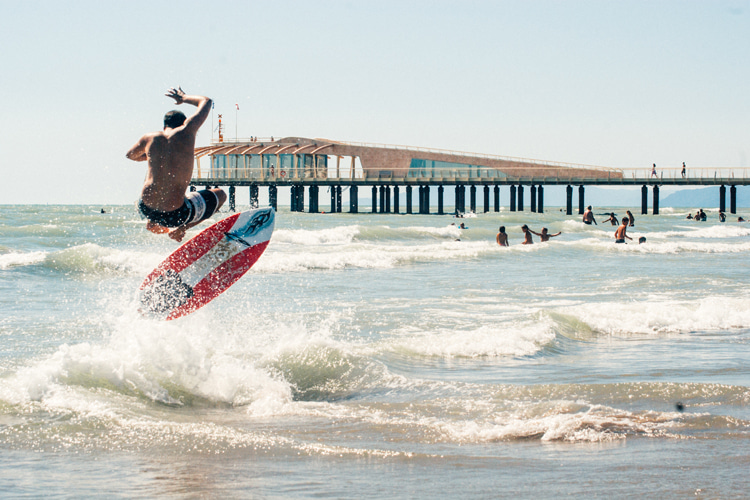Wounds and injuries are just part of any sport. Let's take a look at the particular injuries affecting skimboarders.
There are the basic abrasions, bruises, sprains, and strains that often plague frequent skimmers and the more nasty deep cuts and broken bones.
Most injuries from skimboarding are recurring pains caused by intense, repetitive actions, which are - eventually - unavoidable, although treatable.
In other words, if you are willing to put in the time and effort to keep yourself strong and limber, you may minimize lesions and physical trauma.
The first and most important bit of advice one can give you is to stretch - often. Yoga, for instance, is an excellent go-to option.
Every skimboarder and water sports enthusiast wants to get out there and hit some waves, but stretching is critical.
Your body will thank you, and you will be hurt less often; hence you will be able to skim more. And isn't that the goal?
A little goes a long way, so it's definitely worth it to stretch before, during, and after a skim session.
The second piece of advice is to exercise.
Yes, we've all heard it before, but we can't stress enough how important it is to keep your body fit and strong, especially in areas such as the knees, hips, and back.
These areas go through high-stress levels due to the extreme running, landing, and twisting motions skimmers inflict upon their bodies.
So, you've heard it before, and you'll hear it again - a strong body will recover faster than a weaker one.
It's just smart sense to keep fit if you are serious about skimboarding.
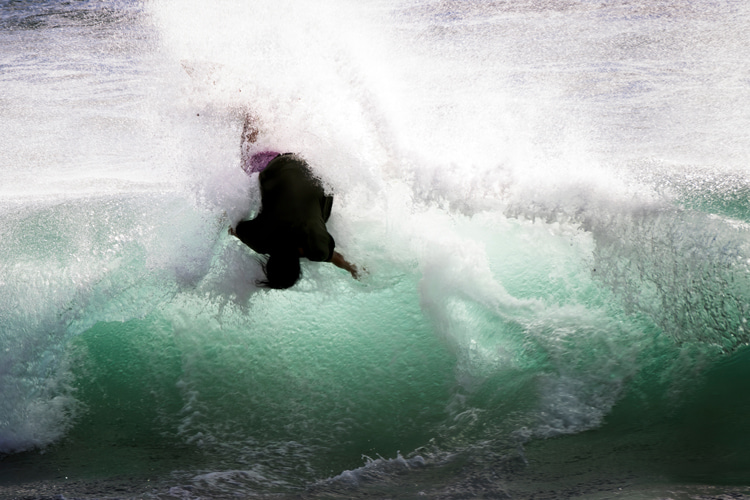
Stay Fit and Anticipate Yourself
A skimboarder destroyed her knee from a nasty bail, after which she could barely walk, let alone skim.
The doctors said she would probably always have a limp. She had to have surgery and wasn't able to skim for almost two years.
But because she had always been very fit and kept up with her training, she was finally able to walk, run, and bike.
She even tried a couple of easy tricks on a skimboard with no limping.
The best injury is no injury. While that is not exactly possible, there are some techniques you can employ to lessen the risk:
- Preventative maintenance;
- Fall with style;
- Skim etiquette;
At some point, however, getting hurt is inevitable.
There are many different types of injuries a skimmer can endure. Some will be quick to heal, while others will continue to reoccur due to repetitive strain injury.
Take a look at the most common injuries related to skimboarding.
Foot and Ankle Injury
Injuries to the foot and/or ankle are probably the most common injury among skimboarders.
They range from a minor bang by a board to a serious sports injury, often due to repetitive strain, twisting, and/or stomping on a hardboard.
Quite often, skimmers' heels become badly bruised to the point where it is too painful to land on a board.
Also, the dangers of an out-of-control board flying through the water like a ninja death star can (and will) cause a serious skim injury by laceration of the ankle or wherever it hits.
Skimboards are hard, and they can slice and dice, and it hurts - a lot - especially when they hit the sensitive areas that they usually do, such as the part of the ankle right near the bone.
There are strengthening exercises specifically driven to avoid nasty ankle injuries and techniques to treat them when they happen.
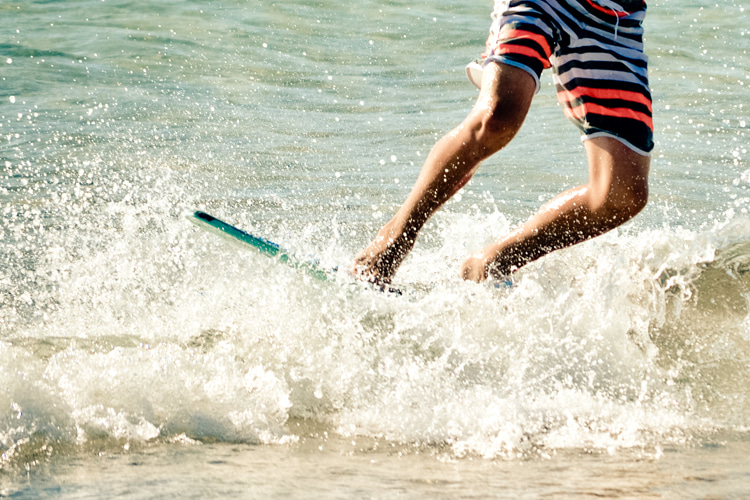
Knee Injury
Knee injuries are not fun and should be avoided at all possible costs because they can often be the end game.
Obviously, no one goes out to intentionally smash their knee up, but there are at least ways to either avoid it or at least minimize the damage.
Find ways to strengthen your knees and avoid hurting them.
Spinal Injury
Spinal injury is probably the worst as it affects your whole body.
Because skimboarders are constantly twisting in obscure positions and getting thrown around, they also frequently suffer spinal skim injuries.
Who has never had a spinal injury from skimming?
Stretching and strengthening your back, core, and shoulder muscles are key to avoiding long-lasting, permanent spinal damage.
Groin Injury
We all know how much these hurt, and because we use our legs starting from the groin area every day in every action, it takes a long, horrible time to heal.
The best way to prevent groin injury is to stretch.
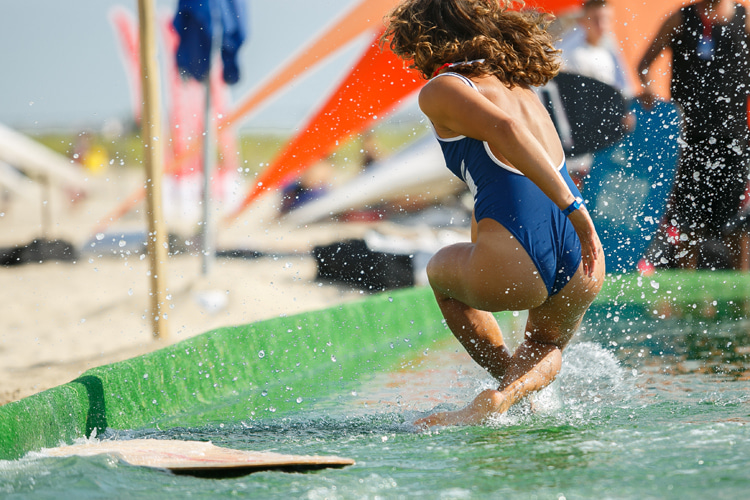
Hip Injury
The average person would think skimmers are a bunch of old fogeys, the way they complain about their hips.
But the fact is that hip flexors are under great strain from all that running and twisting.
Exercises that promote strength in your hips will enable you to run faster, further, and longer.
Sand Rash, Cuts, and Abrasions
Sand tattoos are minor annoyances that are difficult to avoid unless you know how to skim without falling. But we have yet to meet such a person.
This skim injury is mostly caused by crashing into the sand, sometimes scraping along rocks and shells.
Fortunately, the better skimmer you become, the fewer tattoos you will acquire as you fall less often, and when you do, you learn to fall with style.
Fungal Infection
Do you see spots on your skin? From time to time, you may notice strange whiteish spots on your body.
There may be just a few small ones or lots of big and little ones.
Don't worry - chances are it's not skin cancer, although it never hurts to get checked out.
Fungi don't cause any harm to you, but they can be gross and contagious. If not treated, it will grow even though it's quite common.
It is probably caused by spending lots of time in wet environments, and there are not many skimboarders who can do that.
The cure is simple. Get yourself a moisturizer and lather your body.
One or two applications in as many days should be sufficient.
You could also get a prescriptive cream, but a shampoo used to treat certain scalp infections or dandruff might solve the problem.
Nevertheless, chances are you will get the fungus more than once.
After treating your body, the offending spots will still show, even if the fungus is gone.
They will only disappear once they have either tanned to match the rest of your skin or when your tan has faded to match the spots.
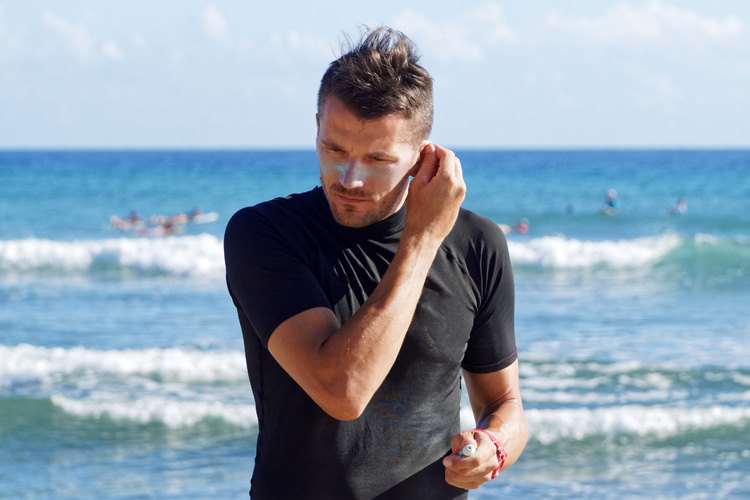
Surfer's Ear
Hearing loss is a common sign of surfer's ear or, technically speaking, exostosis, which is abnormal bone growth in the ear canal.
Frequent ear infections and an inability to clear water and other debris from the ear are other sure indications.
Surfer's ear is an irritation caused by the cold wind and water that makes the bone grow lumps into the surrounding ear canal.
The symptoms of exostosis are as follows:
- Hearing loss, especially noticeable in one ear more than the other;
- Pain, crackling, or popping inside your ear;
- Water trapped inside your ear;
- People tell you to turn music or TV down or that you talk too loudly;
- You constantly ask others to speak up;
If you feel you've got exostosis, visit an otorhinolaryngologist.
Then, if impossible, make sure you get a second opinion - not all doctors are familiar with surfer's ear.
If you suffer from exostosis, prepare for seriously invasive ear surgery.
Treatments are always advancing, but one of the most common methods is to slice off part of your ear and drill into your ear around easily damaged, sensitive nerves, which can leave half your face paralyzed with one wrong, small slip.
In the end, the surgeon will stitch your ear back on. You won't be able to get back to the water for a while after.
The best way to prevent exostosis is simple - use earplugs every time you get to the water. Surfer's ear is easily avoidable.
There's a growing number of skimmers and surfers who absolutely will not go skimming and surfing if they forget their earplugs.
Another option is to wear a hood if it's really cold out there.
Sun Blindness
The future's so bright, so make sure to wear sunglasses.
Think about it for a moment - you're out there all day in the blazing sun, staring directly into the glorious, glaring ocean.
While you're busy spotting for that next wave, the sun is burning into your retinas. Ok, not exactly, but it is damaging your eyes.
There are several health issues associated with excessive solar exposure, including photokeratitis and solar retinopathy.
The constant glare will cause a growth to form over your eyeballs, which can only be removed via a scalpel, scraping the surface of your eye - while you are awake.
Fun right? Well, if you like lots of pain, then you're in for a double treat.
If this doesn't sound like your idea of fun and you would like to continue to use your eyes to see, wear your sunglasses.
Of course, you can't wear them while skimming, but wearing them every other second can possibly reduce the possibility of damage.
Hats can also be helpful in reducing direct sun rays aiming to burn holes into the windows of your soul.
Plus, they can also be worn whilst skimming.
Words by Nicole Rigler | Skimboarder
